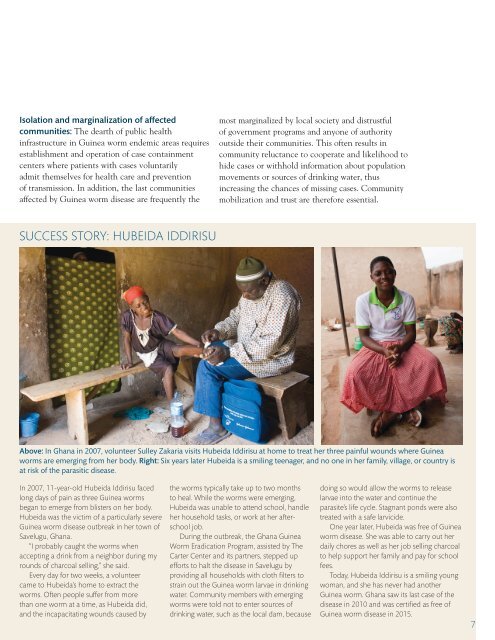ERADICATION OF GUINEA WORM DISEASE
1VIcLdr
1VIcLdr
Create successful ePaper yourself
Turn your PDF publications into a flip-book with our unique Google optimized e-Paper software.
Isolation and marginalization of affected<br />
communities: The dearth of public health<br />
infrastructure in Guinea worm endemic areas requires<br />
establishment and operation of case containment<br />
centers where patients with cases voluntarily<br />
admit themselves for health care and prevention<br />
of transmission. In addition, the last communities<br />
affected by Guinea worm disease are frequently the<br />
most marginalized by local society and distrustful<br />
of government programs and anyone of authority<br />
outside their communities. This often results in<br />
community reluctance to cooperate and likelihood to<br />
hide cases or withhold information about population<br />
movements or sources of drinking water, thus<br />
increasing the chances of missing cases. Community<br />
mobilization and trust are therefore essential.<br />
SUCCESS STORY: HUBEIDA IDDIRISU<br />
Above: In Ghana in 2007, volunteer Sulley Zakaria visits Hubeida Iddirisu at home to treat her three painful wounds where Guinea<br />
worms are emerging from her body. Right: Six years later Hubeida is a smiling teenager, and no one in her family, village, or country is<br />
at risk of the parasitic disease.<br />
In 2007, 11-year-old Hubeida Iddirisu faced<br />
long days of pain as three Guinea worms<br />
began to emerge from blisters on her body.<br />
Hubeida was the victim of a particularly severe<br />
Guinea worm disease outbreak in her town of<br />
Savelugu, Ghana.<br />
“I probably caught the worms when<br />
accepting a drink from a neighbor during my<br />
rounds of charcoal selling,” she said.<br />
Every day for two weeks, a volunteer<br />
came to Hubeida’s home to extract the<br />
worms. Often people suffer from more<br />
than one worm at a time, as Hubeida did,<br />
and the incapacitating wounds caused by<br />
the worms typically take up to two months<br />
to heal. While the worms were emerging,<br />
Hubeida was unable to attend school, handle<br />
her household tasks, or work at her afterschool<br />
job.<br />
During the outbreak, the Ghana Guinea<br />
Worm Eradication Program, assisted by The<br />
Carter Center and its partners, stepped up<br />
efforts to halt the disease in Savelugu by<br />
providing all households with cloth filters to<br />
strain out the Guinea worm larvae in drinking<br />
water. Community members with emerging<br />
worms were told not to enter sources of<br />
drinking water, such as the local dam, because<br />
doing so would allow the worms to release<br />
larvae into the water and continue the<br />
parasite’s life cycle. Stagnant ponds were also<br />
treated with a safe larvicide.<br />
One year later, Hubeida was free of Guinea<br />
worm disease. She was able to carry out her<br />
daily chores as well as her job selling charcoal<br />
to help support her family and pay for school<br />
fees.<br />
Today, Hubeida Iddirisu is a smiling young<br />
woman, and she has never had another<br />
Guinea worm. Ghana saw its last case of the<br />
disease in 2010 and was certified as free of<br />
Guinea worm disease in 2015.<br />
7


